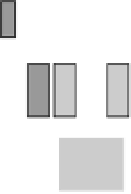Agriculture Reference
In-Depth Information
Crossing
Crossing
F
1
F
1
Single
plants
F
2
F
2
Single plants
F
3
Head row 1
F
3
Head rows
F
4
Bulk yield 1
Head rows
and yield 1
F
4
F
5
Bulk yield 2
F
6
Head row 2
Head
rows and
yield 2
F
5
F
7
Bulk yield 3
Early yield trails
F
7
F
8
Early yield trials
F
9-10
F
8-9
Advanced yield trials
Advanced yield trails
Figure 4.3
Outline of a bulk/pedigree breeding scheme
used for breeding inbreeding crop species.
Figure 4.4
Outline of a modified bulk/pedigree breeding
scheme used for breeding inbreeding crop species.
for evaluation of individual lines in the early genera-
tions and so reducing the number of more highly inbred
lines that can be evaluated. Despite these disadvantages,
bulk/pedigree schemes (or close derivatives of ) are most
commonly used to develop inbred cultivars.
plant selection. An F
2
population is produced by self-
ing F
1
plants from artificial hybridizations. Individual
plant selections from the segregating F
2
populations are
grown in plant progeny rows at the F
3
stage. Selected
F
3
populations are bulk harvested and preliminary yield
trials are grown at the F
4
stage by planting the bulked F
3
seed. F
5
and F
6
bulk seed yield trials are grown, in each
case by planting bulked seed from the previous year's
trial. Selection of populations is based on performance
in these trials. At the F
6
stage single plant selections are
once again made from the now near-homozygous lines.
Progeny from these plant selections are grown then as
plant rows at F
7
; second cycle initial yield trials at F
8
and more advanced yield trials at F
9
.
The advantage of this combined breeding scheme is
that inferior individuals, lines or populations are iden-
tified and discarded early in the breeding scheme. More
than a single cultivar may be derived from a popula-
tion or heterogeneous line identified as being superior
by the earlier generation testing. Disadvantages will
include, with fixed resources, the use of testing facilities
Modified pedigree method
Most breeding schemes have developed breeding
schemes that are combinations of bulk and pedigree
methods. For example the breeding scheme used for
developing winter barley cultivars at the Scottish Plant
Breeding Station was a
modified pedigree trial scheme
(illustrated in Figure 4.4).
The modified pedigree trial breeding scheme enables
yield trials to be grown simultaneously to pedigree
selection. Single plants are selected from amongst seg-
regating F
2
populations. Seed from these selections are
grown as plant progeny rows at F
3
. One, or more, single
plants are selected from each of the desirable F
3
plant
rows, and the remainder of the row is bulk harvested.
The single plant selections are grown as plant progeny

















































































